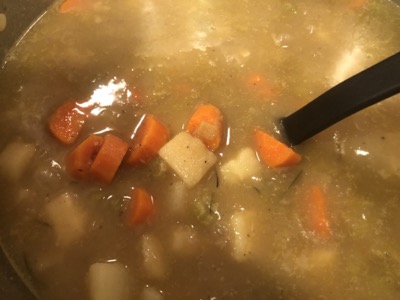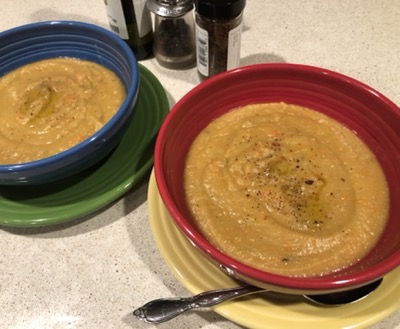
Recipe: Adapt the ingredients to your favorites

The soup is garnished with olive oil, black pepper, crushed Aleppo pepper and cooked bacon. Kathy Morrison
Rainy, then cold, then rainy AND cold – that’s been December so far. All I could think of to make the other day was soup – thick, warming soup, to serve with a big crusty loaf of whole wheat bread.
The New York Times Cooking app came to my rescue, with this easy root vegetable soup that I’ve adapted to boost the flavors. Depending on what you like and/or have in the pantry, the soup can include regular or sweet potatoes, parsnips, rutabagas, turnips, carrots or celery root. These combine with the usual aromatics of onions or leeks, plus garlic and celery.
I like potato-leek soup just fine, and could have gone with just russets, but wanted to make the flavors a little richer, so I included carrots and parsnips in my version. I used 4 potatoes, 3 carrots and 2 large parsnips, for a total of 3-½ pounds of root vegetables before peeling.
I also make and freeze my own vegetable stock, but added some chicken broth and a half-cup of white wine to fill out the liquid needed. And since this was going to be dinner, I cooked a bit of chopped bacon first, then used the fat to brown the onion and leeks. The bacon became the final garnish for a delicious warm meal.
The soup cooks fairly quickly – less an hour, after all the peeling and chopping is done. I used my immersion blender to smooth it all out, but leave it chunky if you like, or maybe blend just half of it.
The bacon, incidentally, is optional, as is just about everything in this recipe. However, I highly recommend a sprinkle of Aleppo crushed red pepper – or any crushed red pepper – as part of the garnish. It gives the soup a delightful pop of heat, and heat is what we all need these chilly days!
Root vegetable soup
Serves 6 to 8
Ingredients:
4 slices of bacon, cut into small pieces, or 3 tablespoons olive oil or butter
1 onion or 2 leeks, or both, trimmed and chopped
3 stalks celery, chopped
3 cloves garlic, smashed and minced
3 sprigs rosemary or thyme
2 bay leaves
Salt
Black pepper
½ cup white wine, optional

8 cups vegetable or chicken broth, or a combination, divided
3-½ pounds of root vegetables, peeled and chopped (a combination of any of these: russet potatoes, sweet potatoes, parsnips, rutabagas, turnips, carrots or celery root)
Juice of ½ lemon
Garnish options:
Freshly ground black pepper
Extra-virgin olive oil
Aleppo pepper flakes or other red pepper flakes
Grated Parmesan cheese
Additional lemon juice
Cooked bacon pieces, reserved from above
Instructions:
If using the bacon, cook it over medium heat in a large, heavy Dutch oven or soup pot until crispy, then remove the cooked bacon and reserve. Otherwise, heat the 3 tablespoons of olive oil or butter in the pot.

Cook the chopped onion and/or leeks and celery in fat until tender, up to 10 minutes, stirring occasionally. Then add the garlic, rosemary or thyme stalks, and the bay leaves, cooking for another minute.
Stir in the white wine if using, then about 2 cups of the broth. Add 2 teaspoons salt and ½ teaspoon black pepper. Stir well. Set aside 1 cup of the rest of the broth for later, then add the remaining 5 cups broth and the chopped root vegetables.
Bring the mixture to a boil, then lower heat and simmer for 30 to 40 minutes until the vegetables are tender. Taste the broth and adjust the seasonings.
Remove the soup from the heat and let it cool slightly. Remove the herb stalks and the bay leaves from the pot. Purée all or some of the soup with an immersion blender or in batches using a regular blender. Return to low heat, and if the soup seems too thick, add the reserved 1 cup broth and heat gently. (Be careful with hot soup! The purée can volcano out of the pot; I have a burn to prove it.) Stir in the lemon juice.
Serve soup in warmed bowls with a drizzle of olive oil and a grinding of black pepper, plus, as desired, a pinch of Aleppo pepper, a few drops of lemon juice, a sprinkling of Parmesan and/or some bacon pieces.
Comments
0 comments have been posted.Sacramento Digs Gardening to your inbox.
Food in My Back Yard Series
May 6: Maintain soil moisture with mulch for garden success
April 29: What's (already) wrong with my tomato plants?
April 22: Should you stock up on fertilizer? (Yes!)
April 15: Grow culinary herbs in containers
April 8: When to plant summer vegetables
April 1: Don't be fooled by these garden myths
March 25: Fertilizer tips: How to 'feed' your vegetables for healthy growth
March 18: Time to give vegetable seedlings some more space
March 11: Ways to win the fight against weeds
March 4: Potatoes from the garden
Feb. 25: Plant a fruit tree now -- for later
Feb. 18: How to squeeze more food into less space
Feb. 11: When to plant? Consider staggering your transplants
Feb. 4: Starting in seed starting
Sites We Like
Garden Checklist for week of May 4
Enjoy this spring weather – and get gardening!
* Plant, plant, plant! It’s prime planting season in the Sacramento area. Time to set out those tomato transplants along with peppers and eggplants. Pinch off any flowers on new transplants to make them concentrate on establishing roots instead of setting premature fruit.
* Direct-seed melons, cucumbers, summer squash, corn, radishes, pumpkins and annual herbs such as basil.
* Harvest cabbage, lettuce, peas and green onions.
* In the flower garden, direct-seed sunflowers, cosmos, salvia, zinnias, marigolds, celosia and asters. (You also can transplant seedlings for many of the same flowers.)
* Plant dahlia tubers. Other perennials to set out include verbena, coreopsis, coneflower and astilbe.
* Transplant petunias, marigolds and perennial flowers such as astilbe, columbine, coneflowers, coreopsis, dahlias, rudbeckia and verbena.
* Keep an eye out for slugs, snails, earwigs and aphids that want to dine on tender new growth.
* Feed summer bloomers with a balanced fertilizer.
* For continued bloom, cut off spent flowers on roses as well as other flowering plants.
* Add mulch to the garden to maintain moisture. Mulch also cuts down on weeds. But don’t let it mound around the stems or trunks of trees or shrubs. Leave about a 6-inch to 1-foot circle to avoid crown rot or other problems.